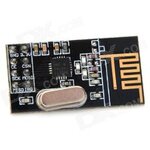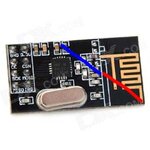Darkcobra
Member level 3
I have two RF modules (2.4Ghz, NRF24L01+ based, pictures follow). One uses a rubber duck antenna, which will be oriented vertically as shown.
The other uses a PCB antenna. There is no ground plane on the opposite side of the PCB area containing the antenna. Is there an optimal orientation of this module for best communications between the two?


The other uses a PCB antenna. There is no ground plane on the opposite side of the PCB area containing the antenna. Is there an optimal orientation of this module for best communications between the two?


